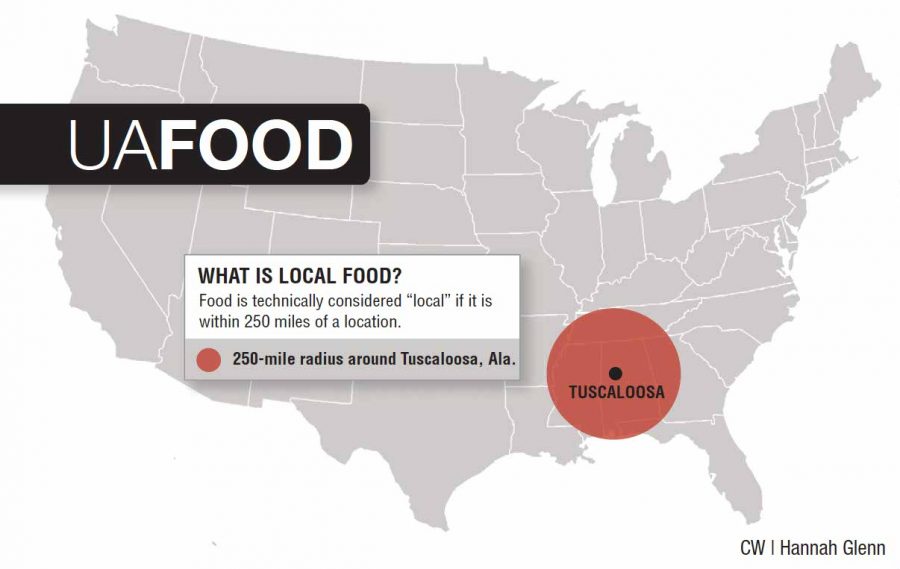From midnight pancakes to unlimited pizza, the myriad offerings at Bama Dining locations seem to appear continuously; the origins of the meals and the ingredients that go into them are, for many students, a mystery.
Karen Varieur, the residential food service director for Bama Dining, said dining halls try to buy locally grown food as much as possible.
“Our produce is purchased through FreshPoint, a company supplied by farmers in the South and Southeast,” Varieur said. “Meat is purchased through Sysco, a third-party food distributor, and they provide local meat when it is available.”
Olivia Bensinger, chair of the Sustainable Food Committee of the Environmental Council, is currently working on a research project with Bama Dining to examine the food choices and determine the best practices for buying local.
Since spring 2011, Bensinger has been working to implement the Real Food Challenge on campus. The Real Food Challenge is a national movement to promote “local, community-based, fair, ecologically sound and humane food sources” in school dining halls.
“I think local and community-based food is really important because it lowers carbon impact, and it helps the economy and local farmers here,” Bensinger said. “Your carbon footprint is basically how much you contribute to carbon emissions and greenhouse gas emissions. If food isn’t being transported as far because it came from a local farmer, it has a lower carbon footprint.”
She said local is defined as food grown within 250 miles of campus, which doesn’t apply to some of the food that comes from the Atlanta-based supplier FreshPoint.
“Anything that is listed local may not be local to our city because it’s coming out of Atlanta, which is not necessarily local,” Bensinger said. “Also, we define local as local and community-based, so if it’s a big-time company that just happens to have a plant in our community, that doesn’t count as local. So we technically source milk from within 250 miles of campus, but Borden Dairy is such a large company that it doesn’t count as local-community based. But at least it doesn’t have hormones in it, which is a good thing.”
(See also “Dining halls should nix buffet style“)
She said the University is required to buy local before it buys imported food. However, the selection of local food is limited because of economic restrictions.
“One of the things they run into is that there aren’t a lot of local vendors that are able to source to Sysco,” Bensinger said. “I think finding a way to get around the Sysco requirements and the certifications that farmers have to have in order for the University to purchase from them is going to be key in that process. The certifications are really expensive, and they’re really prohibitive for a lot of small, local farmers. I think a lot of local farmers could produce the crop quantity that is needed by Bama Dining or at least partially. Buying part of their produce locally is better than none of it, but it’s just those costs are really prohibitive.”
The Real Food Challenge uses a standardized calculator to compare the data from all schools. After two years of working with Bama Dining and ARAMARK, a company that organizes the food supply and creates the menus, Bensinger has received permission to begin using the calculator to evaluate Bama Dining. She said she is hoping to finish the research this semester or at the beginning of next semester.
The biggest goal of the Real Food Challenge is for schools to devote 20 percent of their food spending to real food. According to the Real Food Challenge, colleges and universities across the country spend a combined $5 billion on food, so the goal is to devote $1 billion to real food.
“Right now the market is just not necessarily there for 100 percent real food. That’s just impossible,” Bensinger said. “So I think 20 percent is just a very reasonable goal. Then, if we wanted to strive for more after 2020, that’s always possible.”
Bensinger said she believes Bama Dining is actively trying to improve the quality of its food selection. She said small efforts, such as hand-making some menu items, makes a difference.
“Bama Dining does buy a lot of whole produce that they then cut down themselves,” Bensinger said. “They hand cut all their french fries, they hand-make a lot of their pasta. But a lot of it still is processed, like the baked goods. It’s a lot less common than I thought it would be. I think they’re really trying; I just think they need the guidance of the calculator.”
Kelsey Faust, district marketing manager for ARAMARK’s Higher Education division, said the company strives to provide local and organic food whenever possible, but with certain foods that is not always an option.
“Our goal is to provide the UA community with as many locally and regionally sourced food products as possible,” Faust said. “However, in order to protect our consumers and ensure consistent food safety, we have rigorous standards for safety and sanitation. Unfortunately, not all local providers meet those standards.”
(See also “ECo brings local, community-based food to dining halls“)
Sheena Quizon Gregg, a dietitian and assistant director of health education and prevention at the Student Health Center, said in addition to the environmental benefits, there are also health benefits to eating locally.
“Eating local produce can better ensure a fresher product that hasn’t traveled several hundred miles from a farm across the country,” Gregg said. “Organic produce can limit one’s exposure from pesticides that may have been used with traditional farming techniques.”
Gregg said Bama Dining has improved in its ability to cater to students with special dietary needs.
“In my five years as a dietitian at UA, I have been able to witness the increase in choices that Bama Dining has to offer,” Gregg said. “Vegan and vegetarian options, gluten-free and other food allergies/intolerances have been better addressed by Bama Dining staff. I have also noticed the variety of grab-and-go options that are available to students.”
From a nutritional perspective, Gregg said the best options in the dining halls are always the salad bars and the grilled meats. She said the number-one request she hears from students is a greater variety of vegetables served at dining halls.
Bensinger said she hopes students start thinking about not just variety of food, but source as well. She said the issue of where food comes from is important for everyone to be aware of, not just researchers and Bama Dining staff.
“I think students should be concerned because it directly affects them,” Bensinger said. “You’re eating this food, and you’re putting it into your body, and you need to know whether your meat is grass-fed or grain-fed, specifically for cows, or whether it had hormones. That really affects whether you’re not getting all the nutrients you could get from that hamburger because of the way it’s produced. Start thinking about that and paying attention to all of the chemicals, all the processing. It’s really important to just be aware. It’s important for our health and for the local economy and community all at the same time.”
(See also “Healthy for Life promotes health, wellness in dining halls“)









